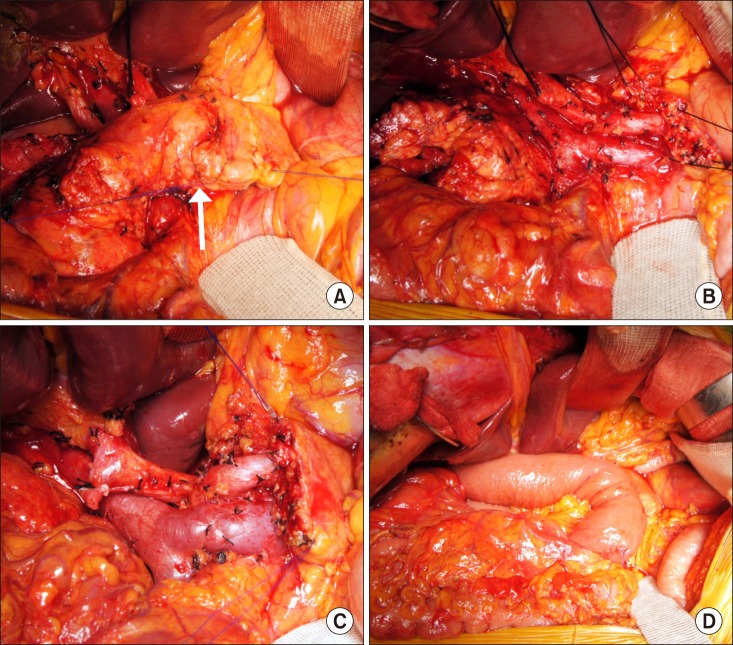Ann Hepatobiliary Pancreat Surg.
2017 Aug;21(3):138-145. 10.14701/ahbps.2017.21.3.138.
Extended pancreatic transection for secure pancreatic reconstruction during pancreaticoduodenectomy
- Affiliations
-
- 1Department of Surgery, Asan Medical Center, University of Ulsan College of Medicine, Seoul, Korea. shwang@amc.seoul.kr
- KMID: 2389990
- DOI: http://doi.org/10.14701/ahbps.2017.21.3.138
Abstract
- BACKGROUNDS/AIMS
Pancreaticoduodenectomy (PD) is associated with various surgical complications including healing failure of the pancreaticojejunostomy (PJ). This study intended to ensure blood supply to the pancreatic stump through extended pancreatic transection (EPT).
METHODS
This study assessed whether EPT reduces PJ-associated complications and whether EPT is harmful on the remnant pancreatic function. The EPT group included 19 patients undergoing PD, pylorus-preserving PD (PPPD) or hepatopancreaticoduodenectomy. The propensity score matched control group included 45 patients who had undergone PPPD. Pancreatic transection was performed at the level of the celiac axis in the EPT group, by which the pancreatic body was additionally removed by 3 cm in length comparing with the conventional pancreatic transection.
RESULTS
A small invagination fissure suspected as the embryonic fusion site was identified at the ventro-caudal edge of the pancreatic body in all patients undergoing EPT. A sizable fissure permitting easy separation of the pancreatic parenchyma was identified in 15 of 19 patients (78.9%). The incidence of significant postoperative pancreatic fistula was significantly lower in the EPT group than in the control group (p=0.047). There was no significant increase in the postoperative de novo diabetes mellitus in EPT group (p=0.60).
CONCLUSIONS
The EPT technique contributes to the prevention of major pancreatic fistula without impairing remnant pancreatic function. EPT is feasible for routine clinical application or at least in patients with any known risk of PJ leak.
MeSH Terms
Figure
Reference
-
1. Trede M, Schwall G. The complications of pancreatectomy. Ann Surg. 1988; 207:39–47. PMID: 3276272.
Article2. Miedema BW, Sarr MG, van Heerden JA, Nagorney DM, McIlrath DC, Ilstrup D. Complications following pancreaticoduodenectomy. Current management. Arch Surg. 1992; 127:945–949. PMID: 1353671.3. Yeo CJ. Management of complications following pancreaticoduodenectomy. Surg Clin North Am. 1995; 75:913–924. PMID: 7660254.4. Aranha GV, Aaron JM, Shoup M, Pickleman J. Current management of pancreatic fistula after pancreaticoduodenectomy. Surgery. 2006; 140:561–568. PMID: 17011903.
Article5. Strobel O, Brangs S, Hinz U, Pausch T, Hüttner FJ, Diener MK, et al. Incidence, risk factors and clinical implications of chyle leak after pancreatic surgery. Br J Surg. 2017; 104:108–117. PMID: 27763684.
Article6. Fu SJ, Shen SL, Li SQ, Hu WJ, Hua YP, Kuang M, et al. Risk factors and outcomes of postoperative pancreatic fistula after pancreatico-duodenectomy: an audit of 532 consecutive cases. BMC Surg. 2015; 15:34. PMID: 25887526.
Article7. Relles DM, Burkhart RA, Pucci MJ, Sendecki J, Tholey R, Drueding R, et al. Does resident experience affect outcomes in complex abdominal surgery? Pancreaticoduodenectomy as an example. J Gastrointest Surg. 2014; 18:279–285. PMID: 24222321.
Article8. Burkhart RA, Relles D, Pineda DM, Gabale S, Sauter PK, Rosato EL, et al. Defining treatment and outcomes of hepaticojejunostomy failure following pancreaticoduodenectomy. J Gastrointest Surg. 2013; 17:451–460. PMID: 23292459.
Article9. Xiong JJ, Altaf K, Mukherjee R, Huang W, Hu WM, Li A, et al. Systematic review and meta-analysis of outcomes after intraoperative pancreatic duct stent placement during pancreaticoduodenectomy. Br J Surg. 2012; 99:1050–1061. PMID: 22622664.
Article10. Haga Y, Wada Y, Takeuchi H, Ikejiri K, Ikenaga M. Prediction of anastomotic leak and its prognosis in digestive surgery. World J Surg. 2011; 35:716–722. PMID: 21184072.
Article11. Guo P, Preuett B, Krishna P, Xiao X, Shiota C, Wiersch J, et al. Barrier function of the coelomic epithelium in the developing pancreas. Mech Dev. 2014; 134:67–79. PMID: 25266457.
Article12. Godlewski G, Gaubert J, Cristol-Gaubert R, Radi M, Baecker V, Travo P, et al. Moving and fusion of the pancreatic buds in the rat embryos during the embryonic period (carnegie stages 13-17) by a three-dimensional computer-assisted reconstruction. Surg Radiol Anat. 2011; 33:659–664. PMID: 21614602.
Article13. Hwang S, Ha TY, Kim JS, Cheong O, Kim KH, Lee SG. Clinical application of sution-type cigarette drain for hepatopancreatoabiliary surgery. J Korean Surg Soc. 2004; 67:428–431.14. Bassi C, Falconi M, Molinari E, Mantovani W, Butturini G, Gumbs AA, et al. Duct-to-mucosa versus end-to-side pancreaticojejunostomy reconstruction after pancreaticoduodenectomy: results of a prospective randomized trial. Surgery. 2003; 134:766–771. PMID: 14639354.
Article15. Bassi C, Dervenis C, Butturini G, Fingerhut A, Yeo C, Izbicki J, et al. Postoperative pancreatic fistula: an international study group (ISGPF) definition. Surgery. 2005; 138:8–13. PMID: 16003309.
Article16. Facy O, Chalumeau C, Poussier M, Binquet C, Rat P, Ortega-Deballon P. Diagnosis of postoperative pancreatic fistula. Br J Surg. 2012; 99:1072–1075. PMID: 22539219.
Article17. El Nakeeb A, Salah T, Sultan A, El Hemaly M, Askr W, Ezzat H, et al. Pancreatic anastomotic leakage after pancreaticoduodenectomy. Risk factors, clinical predictors, and management (single center experience). World J Surg. 2013; 37:1405–1418. PMID: 23494109.
Article18. Strasberg SM, Drebin JA, Soper NJ. Evolution and current status of the Whipple procedure: an update for gastroenterologists. Gastroenterology. 1997; 113:983–994. PMID: 9287993.
Article19. Jung DH, Hwang S, Lee SG. An analysis on the amount of excreted pancreatic juice after pancreatoduodenectomy. Korean J Gastroenterol. 2004; 43:309–315. PMID: 15156118.
- Full Text Links
- Actions
-
Cited
- CITED
-
- Close
- Share
- Similar articles
-
- Anterior pancreatic duct split prior to duct-to-mucosa pancreatico-jejunal anastomosis in pancreaticoduodenectomy
- A Case of a Traumatic Pancreatic Neck Transection Treated with a Binding Pancreaticogastrostomy
- Isolated Traumatic Injury of the Pancreatic Head: A Case Report
- A modified single jejunal loop reconstruction by performing proximal gastrojejunostomy after Whipple's pancreticoduodenectomy in a low-volume hospital
- Endoscopic Treatment of Main Pancreatic Duct Transection, Accompanied with Pseudocyst after Abdominal Trauma, with Using Pancreatic Duct Stent: A Case Report





